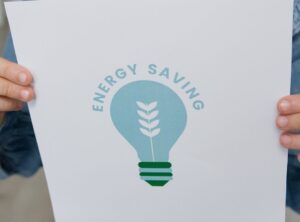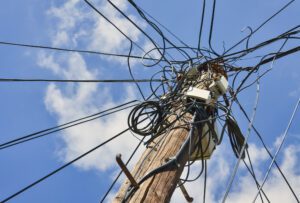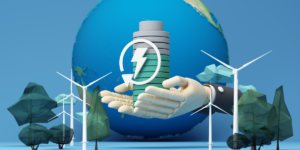The Man in the Big Red Suit Goes Green
Santa Claus has some big boots to fill. Just exactly how much energy does it take for Santa to deliver presents for kids all around the world? Santa is known for his special red suit, but this year, word is that the North Pole is going green! If Santa and his helpers can use renewable energy, then we all can. Let’s see just how much energy it takes for Santa’s big trip!
How Much Energy Does Santa Use?
To answer this question, let’s take a look at just exactly how the big guy does it, using information from the North Pole Accounts Payable department and information in the public domain about Santa’s fixed assets. To operate Santa’s flying sleigh, an energy output of around 10 million kilowatts is needed for the 31 hour round trip, according to estimates by one scientist. That’s a lot of fuel consumption–and potentially a lot of emissions. But fortunately, Santa has a unique trick up his sleeve (or in his bag!) to offset his carbon footprint.
How Long Does His Trip Take?
Generally speaking, we know that Santa delivers gifts over the course of Christmas Eve, although he’s also been known to deliver both earlier and later. But it’s important to take into consideration the rotation of the Earth. This means that for the bulk of present delivery, Santa has approximately a 31 hour time frame to make a roundtrip across the world and back to the North Pole. No wonder he started using postal service helpers!
Does Santa Consume a Lot of Resources?
If the sleigh uses so much power, then it must have an engine, correct? Actually, the sleigh doesn’t have an engine at all (although Santa was recently spotted delivering gifts in a 2022 Tesla Model X). Santa now relies exclusively on reindeer power to fly his sleigh. But staying up all night delivering presents is tiring, so that’s why Santa has to eat cookies. He especially likes chocolate chip cookies since chocolate is a natural source of caffeine. Go figure!
Santa’s New ReNEWable Energy!
That’s right, Santa’s reindeer are a renewable energy source! In fact, Santa has taken to converting many of his operations to renewable fuel sources. In the past, coal was used to power many things at the North Pole, including the Polar Express, the furnaces in the toy factory, and various other boilers and radiators throughout the reindeer sheds and village.
The Secret Behind the Coal
Since Santa has switched to renewable, eco friendly resources like solar power and wind, he has no need for the massive amounts of coal required to keep the North Pole running. This is why children on the naughty list receive coal in their stockings, as there’s nothing worse than a high emission, exhaustible carbon-based fuel supply!
Does Weather Affect the Energy Cost?
Weather can affect the energy cost in several ways. Intense snow, wind, or other turbulent conditions can affect the momentum of the sleigh and create resistance. Increased resistance means a higher demand for fuel. However, like most air based transportation, these costs are minimal. One extra energy cost Santa might incur is if it becomes difficult to see through the weather. He will need his lead reindeer, Rudolph, to light his nose and illuminate his path. If Rudolph kept his nose lit for the entire 31 hour trip, this would incur an additional 100,000 kilowatts.
There’s Dasher and Prancer, Donner and Blitzen…
No renewable energy source is 100% perfect. There’s always at least some form of impact or byproduct produced, however small. In the case of Santa’s reindeer, the chief byproduct produced by the lovable animals is methane, which is released through their flatulence. Some researchers have suggested that the total amount of methane released globally by farm animals is a key contributor to the greenhouse gas problem. However, Santa only has nine reindeer that we know of, so this output is hardly noticeable.
Does it Help to Leave Carrots for the Reindeer to Eat?
Carrots are absolutely essential to power the reindeer. They are high in vitamin A and beta-carotene, which studies suggest can improve the ability to see in the dark. If you’re already leaving out cookies for Santa, consider leaving some carrots for the reindeer!
A Worldwide Effort!
The holiday season is special to many people all over the world. This year, the world is coming together to make a difference regardless of what we celebrate–and make it a green holiday season! Earlier this year, Muslim families showed how we can save energy and create a beautiful holiday ambience by having a candlelit evening during the observance of Mawlid. Candlelight is all you need for a joyous family gathering, which is why Jewish families this year are playing with the dreidel and reciting their blessings by the flickering light of the menorah! Turning off the lights may seem it won’t make much of a difference, but when we all do our part, we can be stronger together!
A Sustainable Christmas
It’s more important than ever to make good choices now for a better future later. But the truth is, making the switch to sustainable energy has a wealth of benefits in both the short and long term.
The Smelly Truth
One could only dream of harnessing the magical reindeer power like Santa does. But for all of us south of the North Pole, we’re reliant upon the resources around us. Some day, our supply of coal will be exhausted, and who knows what Santa will give naughty kids then (word is that it might be reindeer droppings, as they are a natural byproduct of his sustainable energy source). Our resources are depleting fast, and businesses are feeling the effects right now.
What Can be Done to Invest in and Use Sustainable Energy Sources?
Can you imagine if Santa didn’t use renewable resources? That would be one mighty expensive trip! If one kilowatt of power is $0.05 give or take, and Santa’s sleigh uses an estimated 10 million kilowatts, then it would cost the equivalent of $500,000 USD to power the sleigh for just one night!
Instead, Santa’s energy costs are practically zero. Mrs. Claus tends to a garden to feed the reindeer, which incurs about $250 annually, not including the personal loan he took out to build the deluxe greenhouse. If Santa’s payments are $500 a month, in addition to his $1,000 mortgage, then his net cost per kilowatt of energy is likely around $0.000175 on the dollar.
It should be noted that the solar panels installed to heat the reindeer barn have been paid off already. Word is that Santa decided to diversify his portfolio and invest in the volatile yet often high-yielding biotechnology sector. If his investments generate a high enough return, he can install sprinklers in the greenhouse! Although, Mrs. Claus thinks he should pay off the loan first and consider purchasing sprinklers later with their tax return.
The best thing to do for investing in and taking advantage of sustainable energy sources is to buy now. The best time to plant a tree was twenty years ago, and the next best time is now. Before long, your fuel source will pay off itself, but not if you wait to take the plunge.
Wishing You a Joyous Holiday Season!
What do you think? Are we in for a white Christmas, or a green one this year? However you choose to celebrate, we humbly wish you a joyous holiday season! Cheers!
"*" indicates required fields






